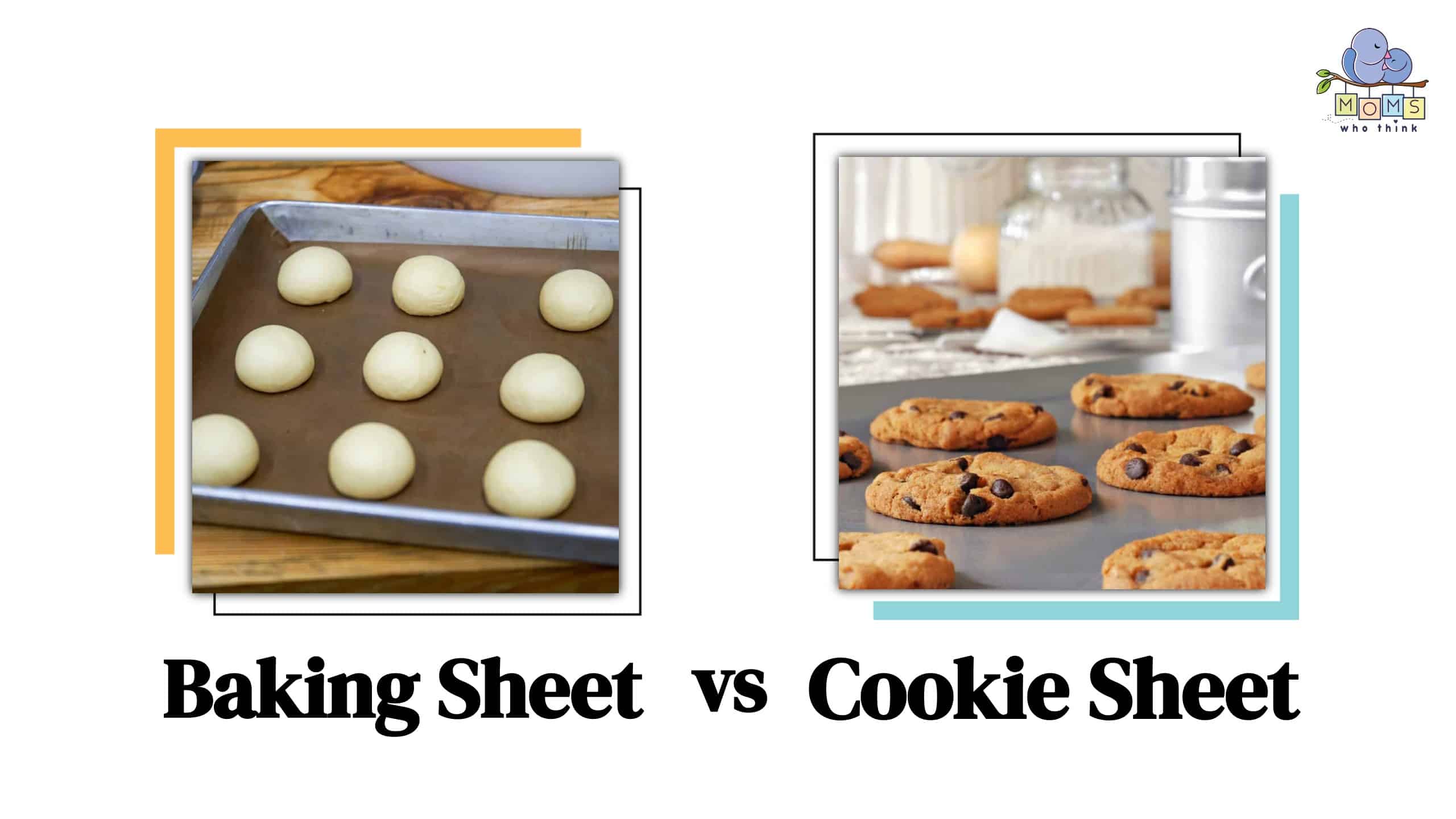Both cookie sheets and baking sheets are necessary kitchen tools that are often used interchangeably, even though they are not exactly the same. But did you know there are actually differences between the two?
Understanding the difference between a cookie sheet and a baking sheet can impact the outcome of your baked goods. In this article, we will discuss the various characteristics, purposes, and materials of cookie sheet vs. baking sheet so you can determine which is the most suitable one for your baking needs.
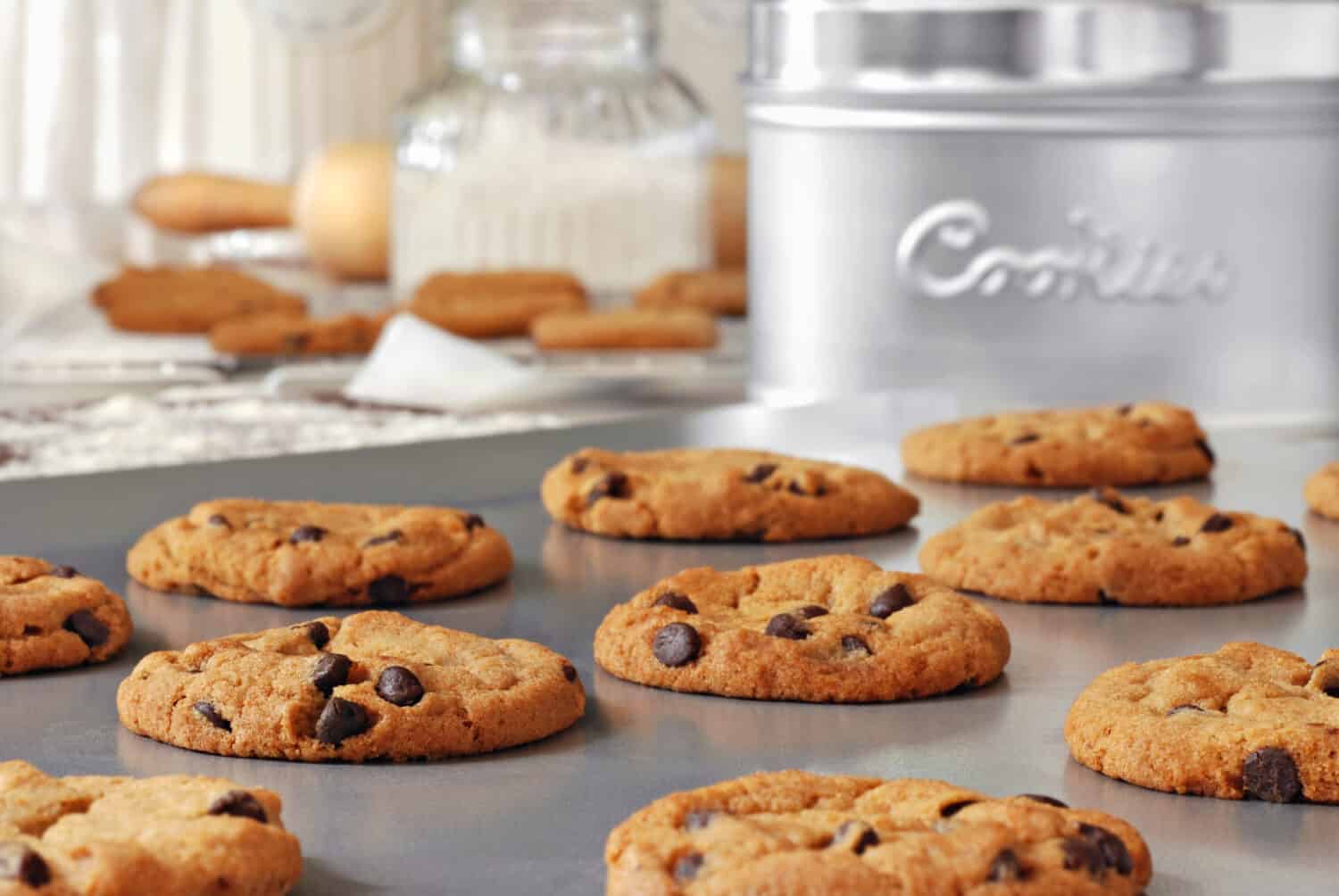
©Marie C Fields/Shutterstock.com
Cookie Sheet vs. Baking Sheet: What is the Difference?
The primary difference between a cookie sheet and a baking sheet is that baking sheets have raised edges on all four sides to prevent spilling of juices while cookie sheets are rimless. Cookie sheets often have a raised edge for handling, but their sides being flat allows for easy removal of cookies.
A cookie sheet and a baking sheet are both flat, rectangular pans used for baking in the oven. However, a cookie sheet is typically used for baking cookies, as its name implies. The raised edge of baking sheets serves as a barrier to prevent food and liquids from spilling off the pan, making it ideal for baking items that produce liquids, such as roasted vegetables, meat dishes, and pizza.
- The must-have convenient reference guide for every home cook!
- Includes more than 8,000 substitutions for ingredients, cookware, and techniques.
- Save time and money on by avoiding trips to grab that "missing" ingredient you don't really need.
While cookie sheets and baking sheets may seem interchangeable, their differences can affect your baking results. Using a cookie sheet for something that requires a raised edge can lead to liquid spilling over the side of the pan, causing a mess in the oven. Similarly, using a baking sheet for something that requires a rimless edge can affect the cooking time and the texture of the food.
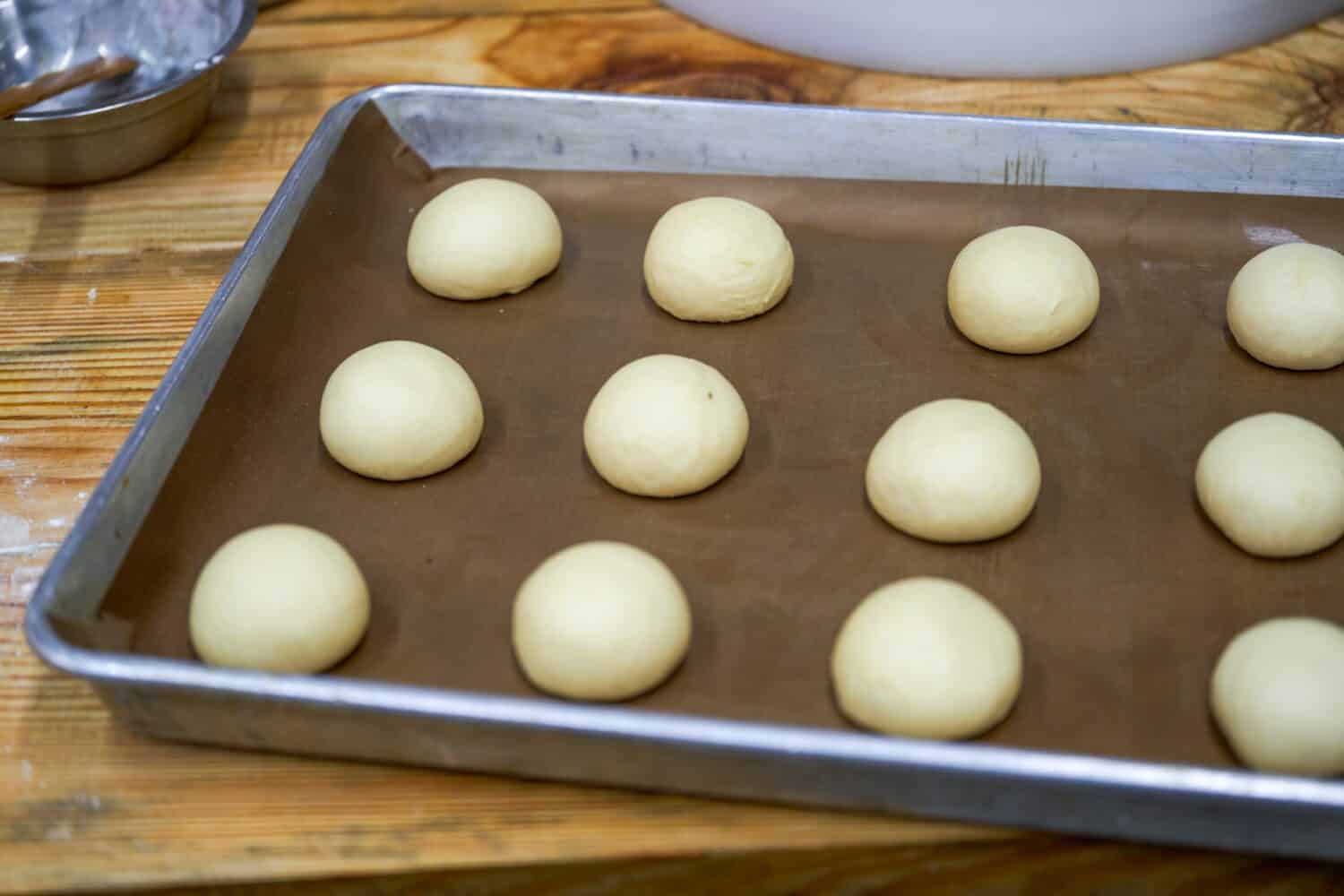
©HiTecherZ/Shutterstock.com
The History of Cookie Sheet and Baking Sheet
The baking sheet dates back to ancient Egyptians, where they were made from earthenware and used to bake bread. They would use a heat source, such as a fire, to heat the clay, which would then be used to bake the flatbread.
In the Middle Ages, baking sheets were made of iron and were used to bake breads and pastries. The sheets were heated over an open fire and then used to bake the dough. These sheets were known as baking plates.
In the U.S., the earliest cookie sheets were made from tin-plated steel. The creator is James Y. Watkins (1807-1883) of New York, NY; Watkins was a tinsmith and owner of a kitchen furnishings warehouse. These sheets were typically heavy and prone to rusting. In the early 1900s, aluminum cookie sheets began to appear. These sheets were lighter and more durable than tin-plated steel sheets and quickly became the preferred choice for baking. The cookie sheet is a relatively modern invention that came about with the rise of the chocolate chip cookie in the 1930s. In 1938 Ruth Graves Wakefield added a chopped-up Nestle chocolate bar to a cookie recipe. As cookies became more popular, a flat, rimless pan was needed to accommodate the dough.
Materials Used in Making a Cookie Sheet
You can often find a non-stick coating on the surface of a cookie sheet, which makes it easier to clean after use. Cookie sheets are typically made from aluminum, stainless steel, or a combination of the two, however, some might be made from glass or silicone instead. Aluminum is an excellent conductor of heat, ensuring even baking, while stainless steel is durable and resistant to rust.
Materials Used in Making a Baking Sheet
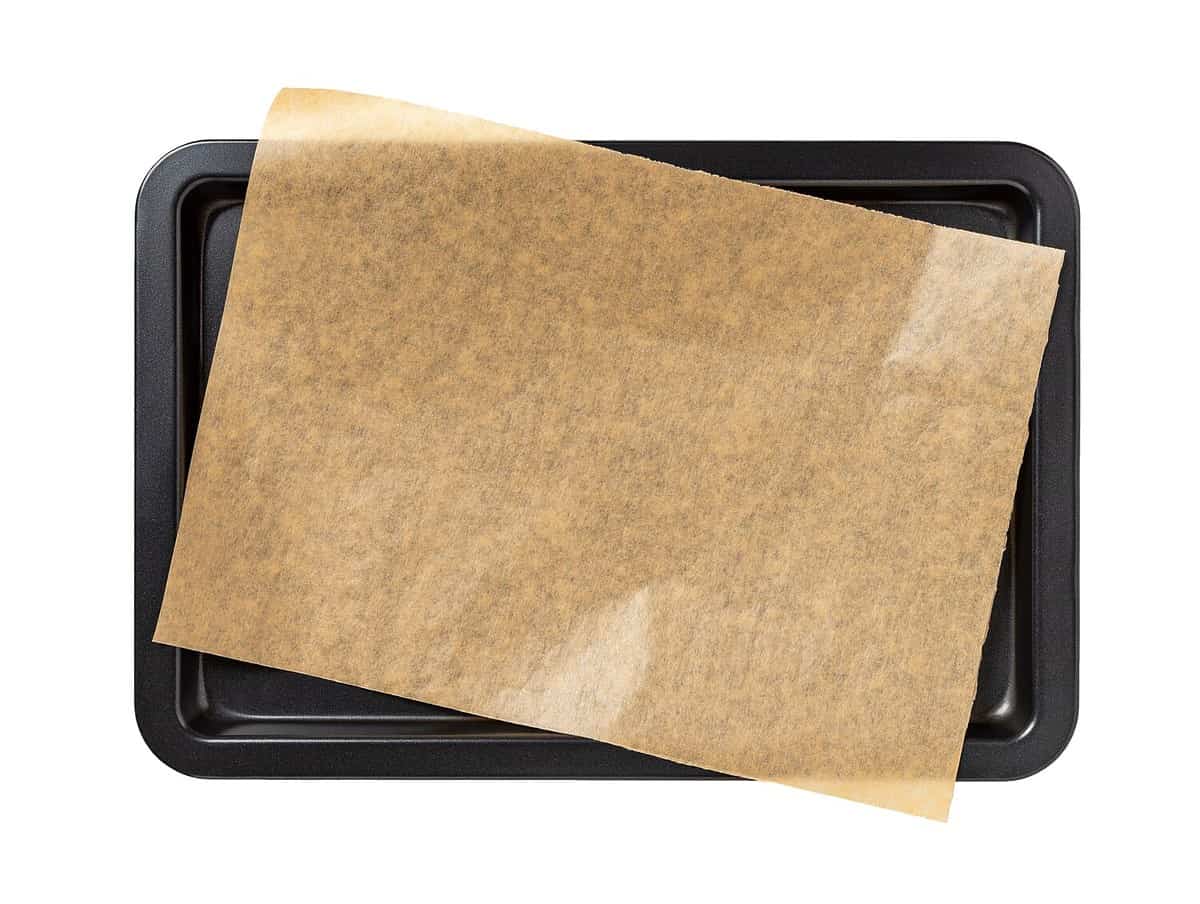
©Maryia_K/Shutterstock.com
Baking sheets are also commonly made from aluminum or stainless steel. However, some baking sheets are made from aluminized steel, which is a steel core coated with an aluminum-silicone alloy. This combination provides the benefits of both materials for even baking and durability.
Advantages and Disadvantages of Each Material
Aluminum heats up quickly and evenly, making it an excellent choice for delicate pastries and cookies. However, it can react with acidic ingredients, such as tomatoes or lemon juice, causing a metallic taste. Stainless steel is durable and resistant to rust, but it can heat unevenly and cause certain foods to stick. Aluminized steel offers the benefits of both materials but can be more expensive.
Size and Shape
Both cookie sheets and baking sheets come in a variety of sizes and shapes, from small and round to large and rectangular. However, cookie sheets are usually rectangular and larger than baking sheets, to accommodate multiple cookies.
Depth and Thickness
Cookie sheets and baking sheets can range in depth and thickness. A thicker pan will hold heat better and bake more evenly, but it may take longer to heat up. A shallow pan may cook faster but can lead to uneven browning. It is best to preheat your sheet in the oven first, this also cuts down your total cooking time.
Surface and Coating
The surface of a cookie sheet or baking sheet can be smooth or textured. Rougher surfaces can help food release more easily, while smoother surfaces can be easier to clean. Some sheets may also have non-stick coatings, which can prevent food from sticking but may not be ideal for high-heat cooking.
Maintaining your Cookie Sheet and Baking Sheet
Maintaining and taking care of your baking sheets is important if you want them to last long. Both cookie sheets and baking sheets come in various materials, such as aluminum, stainless steel, non-stick, and more. Here are some tips for maintaining and caring for them:
- The must-have convenient reference guide for every home cook!
- Includes more than 8,000 substitutions for ingredients, cookware, and techniques.
- Save time and money on by avoiding trips to grab that "missing" ingredient you don't really need.
To clean your baking sheets, first, remove any food residue or crumbs. Then, wash the sheets with a soft sponge and soapy warm water. For tough stains, you can use a mixture of baking soda and hydrogen peroxide, but avoid using metal scouring pads as they can scratch the surface. Finally, rinse the sheets thoroughly and dry them with a cloth.
Storage Tips for Cookie Sheet and Baking Sheet
When storing your baking sheets, make sure they are completely dry, by stacking them vertically you can save space. If you have limited storage space, you can also hang them using hooks or a magnetic holder.
Size of Your Oven
Make sure to measure the size of your oven before buying a cookie sheet or baking sheet. Standard sizes are 13×18 inches, which may not fit in smaller ovens.
Budget
Finally, consider your budget and personal preferences. Non-stick materials may cost more but can be easier to clean, while stainless steel may be more durable it is more expensive.
Conclusion: Which One Should You Choose?
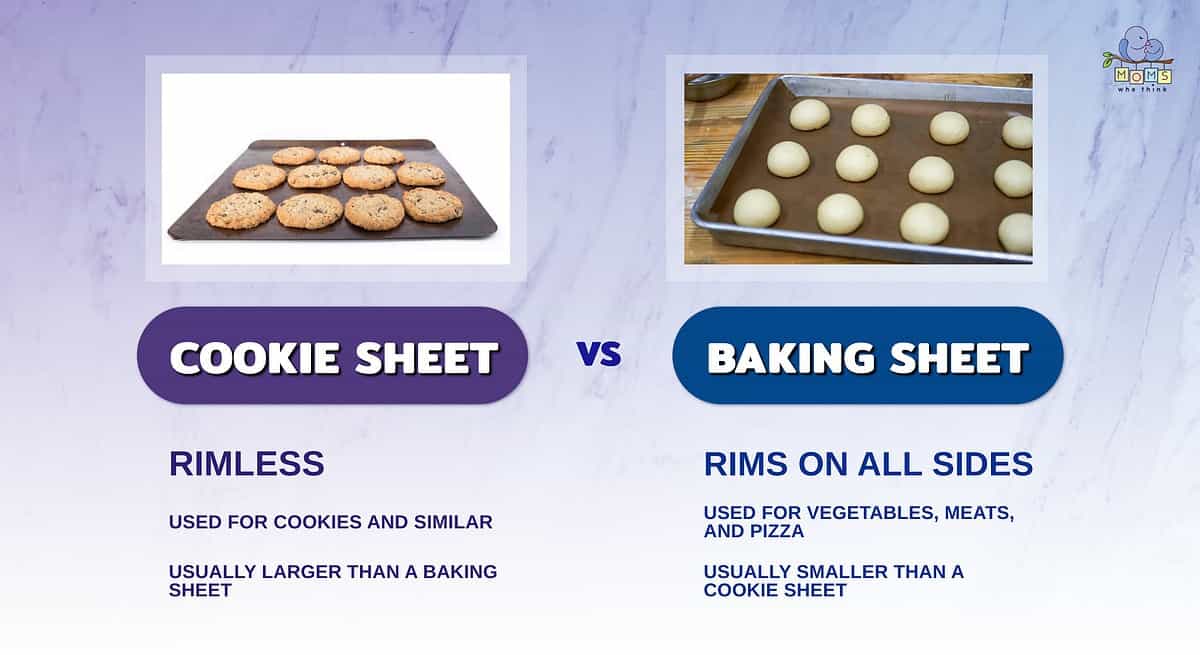
- A cookie sheet is rimless, allowing for the cookies baked on it to be easily removed. A baking sheet has rims on all sides so any liquid doesn't spill out of the sheet.
- Like the name suggests, a cookie sheet is typically used for cookies and similar. A baking sheet can be used for a range of dishes, from vegetables to pizza.
- Cookie sheets and baking sheets can be all sorts of sizes, but cookie sheets are often larger than baking sheets.
In summary, both cookie sheets and baking sheets have their advantages and disadvantages. It depends on your personal preferences, cooking frequency, and the type of food you'll be cooking. We hope that this article has helped you to make an informative decision when choosing the correct sheet for your next kitchen adventure.
Frequently Asked Questions
What is the difference between a cookie sheet and a baking sheet?
A cookie sheet is designed for baking cookies and other small baked goods such as scones and pastries. It usually has no sides or a low rim, allowing cookies to slide off easily. On the other hand, a baking sheet has a raised edge that prevents food from sliding off, making it perfect for baking pizza and roasting vegetables.
What material should I choose for my baking sheet?
The most commonly used materials for baking sheets are aluminum, stainless steel, and non-stick-coated metal. Each material has its own advantages and disadvantages, so consider your baking needs and preferences when selecting a baking sheet.
Should I put parchment paper on my cookie and baking sheet?
When baking cookies, lining a baking sheet will not only help the cookies bake more evenly, but the non-stick surface will also prevent the cookies from breaking or cracking when you remove them from the sheet parchment paper is the ideal coating for baked goods.
Cookie Recipes
Print
Deep Dark Chocolate Cookies
Description
If you are in the mood for some rich, fudgey chocolate goodness, these cookies are the perfect thing to satisfy your craving.
Ingredients
- 8 oz. bittersweet baking chocolate squares
- 3 large egg whites, room temperature
- 2 cups powdered sugar, divided
- 1/2 cup cocoa powder
- 1 tbsp. corn starch
- 1/4 tsp. salt
- 1/2 cup semi-sweet chocolate chips
Instructions
- Melt chocolate in bowl in microwave, stirring twice. Cool slightly.
- Using electric mixer, beat egg whites until soft peaks form.
- Gradually beat in 1 cup sugar until smooth and shiny.
- In separate bowl, whisk 1 cup sugar, cocoa powder, corn starch and salt.
- On low speed, add dry ingredients to egg mixture and mix until combined.
- Stir in melted chocolate and chocolate chips.
- Place 1/2 cup powdered sugar in bowl.
- Roll 1 rounded tablespoon of dough into powdered sugar and place on greased cookie sheet.
- Bake at 350 for 10 minutes.
Today is the perfect day to have some fun in the kitchen and bake some delicious cookies! Baking is a great way to spend time with friends or family, and it's also a way to show off your skills in the kitchen. Gather your ingredients, preheat the oven, and get ready to have a blast.
- The must-have convenient reference guide for every home cook!
- Includes more than 8,000 substitutions for ingredients, cookware, and techniques.
- Save time and money on by avoiding trips to grab that "missing" ingredient you don't really need.
